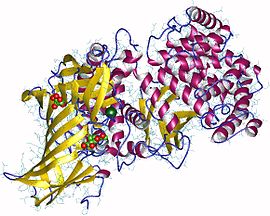Aminopeptidase
 Crystal structure of the open state of human endoplasmic reticulum aminopeptidase 1 ERAP1[1] | |||||||||
| Identifiers | |||||||||
|---|---|---|---|---|---|---|---|---|---|
| Symbol | Peptidase_M1 | ||||||||
| Pfam | PF01433 | ||||||||
| MEROPS | M1 | ||||||||
| OPM superfamily | 227 | ||||||||
| OPM protein | 3mdj | ||||||||
| CDD | cd09595 | ||||||||
| Membranome | 534 | ||||||||
| |||||||||
Aminopeptidases are
Aminopeptidases occur in both water-soluble and membrane-bound forms and can be found both in various
Some aminopeptidases are
History
The discovery and characterization of aminopeptidases date back to the early 20th century. The term "aminopeptidase" was first introduced in 1929 by Linderstrøm-Lang and Sato in order to describe
In the 1950s and 1960s, the discovery of
The subsequent decades[
Structure and classification
Aminopeptidases are a diverse group of enzymes that play crucial roles in various biological processes, including
The structure of aminopeptidases varies depending on the specific enzyme, but they generally consist of a
Metalloaminopeptidases
Metalloaminopeptidases require metal ions, such as
Cysteine aminopeptidase
Cysteine aminopeptidases, on the other hand, rely on a
Biological role
In general, aminopeptidases play an important role in the metabolism of both proteins and peptides. Aminopeptidases in the gastrointestinal tract, such as APN and APA, are essential for the digestion of dietary proteins. They facilitate the absorption and utilization of amino acids by cleaving them from the N-terminus of peptides.[12] These enzymes also play a role in the metabolism of bioactive peptides, including hormones and growth factors. By regulating the levels of these peptides, aminopeptidases contribute to homeostasis and physiological process modulation.[12]
Bacterial aminopeptidases
In bacteria, aminopeptidases are produced by both
Fungal aminopeptidases
Fungi, particularly species like Aspergillus oryzae and Aspergillus sojae, produce aminopeptidases that have applications in the food industry as debittering agents.[14] These enzymes are also of interest for their potential biotechnological applications. For example, leucine aminopeptidase (LAP) from Aspergillus species has been found to be thermostable and could theoretically be used to control the degree of hydrolysis and flavor development in a wide range of substances.[14]
Mammalian aminopeptidases
In mammals, aminopeptidases are produced in various tissues and organs, such as the liver, kidney, and intestine. Due to their ability to break down proteins and peptides, they are used in to help digest proteins, regulate peptide-mediated effects, and break down bioactive peptides.[4] Aminopeptidase N (AP-N) is particularly abundant in the brush border membranes of the kidney, small intestine, and placenta, and is also rich in the liver.[4] It has a broad substrate specificity (ability to bind to its targets) and is involved in the final stages of the digestion of peptides generated from breaking-up and hydrolysis of proteins by gastric and pancreatic proteases.[4]
Medicine and biotechnology
Aminopeptidase has been studied for use in treating hypertension, inflammation, and some cancers. Aminopeptidase A (APA) is implicated in blood pressure regulation by converting angiotensin II to angiotensin III. APA inhibitors are being explored as potential antihypertensive agents, offering a novel approach to managing hypertension.[12] Aminopeptidase N (APN) has been associated with the pathogenesis of inflammatory diseases such as rheumatoid arthritis and inflammatory bowel disease. Inhibitors of APN have demonstrated anti-inflammatory effects in animal models, positioning them as potential therapeutic agents for these conditions.[12] Several aminopeptidases, including APN, APA, and leucine aminopeptidase (LAP), are overexpressed in various cancers. Their involvement in tumor growth, invasion, and angiogenesis makes them attractive targets for cancer therapy. Aminopeptidase inhibitors have shown promise in preclinical studies as potential anticancer agents.[12]
Diagnostic markers
The activity and expression levels of aminopeptidases have been explored as diagnostic markers for diseases like liver disorders and cancer. Variations in these parameters can indicate pathological conditions, aiding in disease diagnosis and monitoring.[12]
Biosensors
Aminopeptidases have been utilized in creating biosensors for detecting specific amino acids or peptides. These biosensors generate a measurable signal in the presence of the target analyte, leveraging the catalytic activity of aminopeptidases.[12]
Protein sequencing
In protein sequencing, aminopeptidases are employed in the Edman degradation method. This technique involves the sequential removal and identification of the N-terminal amino acid of proteins, facilitating the elucidation of their amino acid sequence.[15]
Food industry
In the food industry, aminopeptidases from Aspergillus oryzae and Aspergillus sojae are utilized for debittering protein hydrolysates, including those used in soy sauce and miso production. These enzymes help remove bitter-tasting peptides, enhancing the flavor and palatability of these products.[15] Aminopeptidases also play a crucial role in cheese ripening by participating in the proteolysis of milk proteins. This enzymatic action contributes significantly to the development of the cheese's flavor and texture, making aminopeptidases essential in the cheese-making process.[15]
When aminopeptidases are used in food processing, it is crucial to ensure that they are food-grade and safe for consumption. Aminopeptidases from
Aminopeptidases require specific storage conditions to maintain their stability and enzymatic activity. For instance, human aminopeptidase A is stable at a pH range of 7.0-8.5 and can be stored at -20°C for several months without significant loss of activity. Similarly, a halotolerant intracellular protease from Bacillus subtilis strain FP-133, which exhibits aminopeptidase activity, retains full activity after being stored in 7.5% (w/v) NaCl at 4°C for 24 hours.[17] These examples indicate that aminopeptidases generally require neutral pH conditions and can be stored at low temperatures, such as -20°C or -80°C, for extended periods to preserve their activity.
See also
References
- ^ PMID 21508329.
- S2CID 23354720.
- ISBN 978-0-12-378631-9
- ^ ISBN 978-0-12-382219-2
- ISBN 978-1-4020-5376-4
- S2CID 73436841.
- ^ PMID 31737443.
- ^ PMID 17346152.
- ^ S2CID 37896195.
- ISBN 978-0-12-088488-9
- S2CID 205851962.
- ^ PMID 32342144.
- ^ PMID 8703509.
- ^ PMID 16305677.
- ^ PMID 36625962.
- ISSN 2581-9615.
- PMID 16847833.
External links
- Aminopeptidases at the U.S. National Library of Medicine Medical Subject Headings (MeSH)
